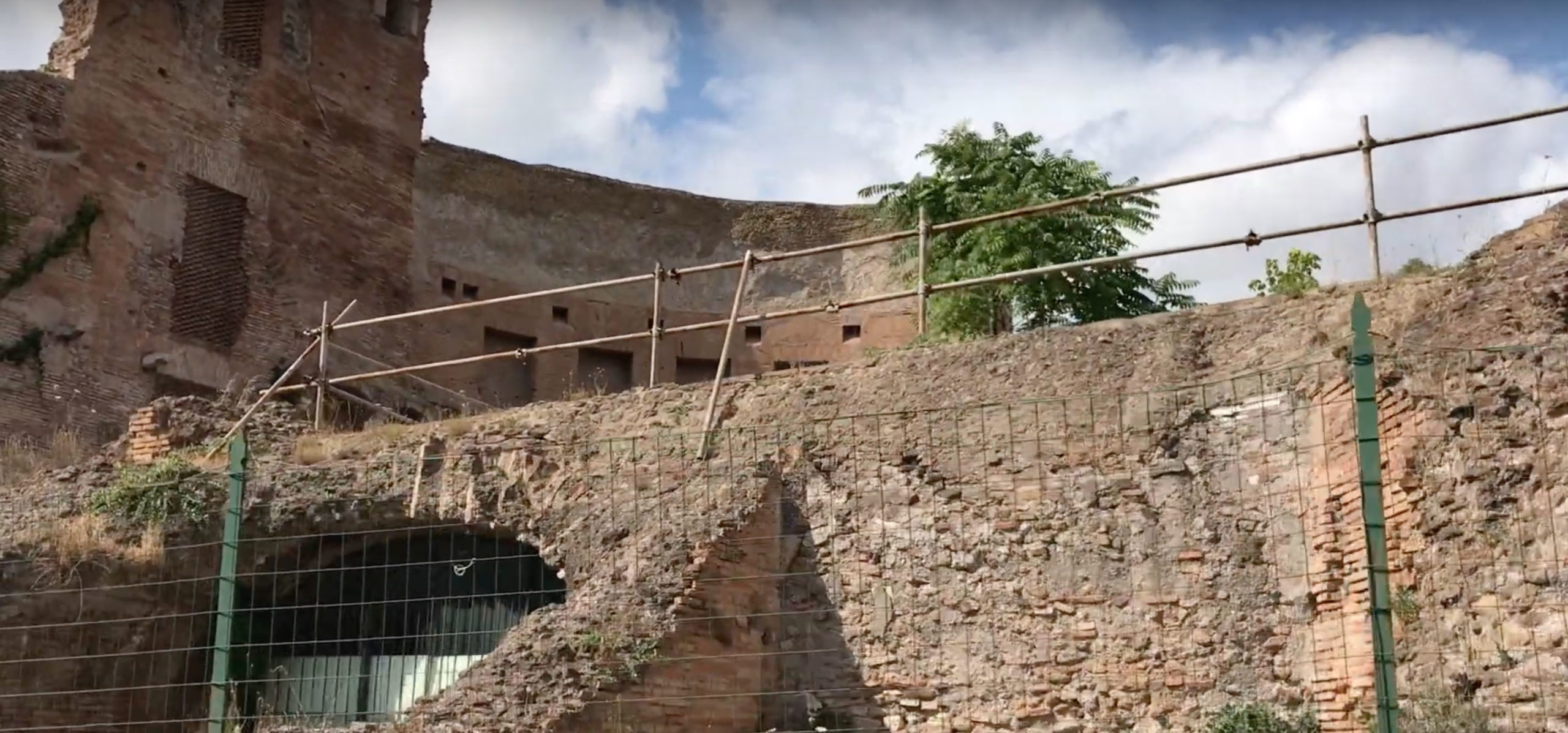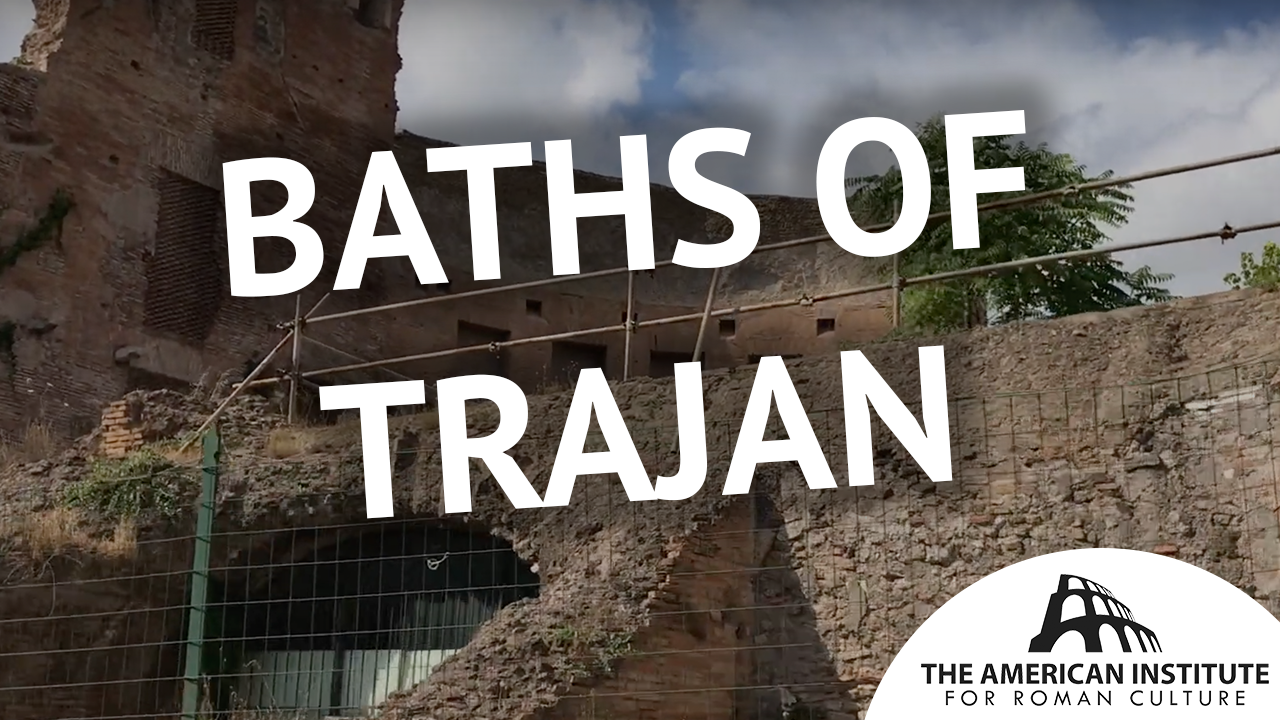Start with our video overview:
Once part of the Esquiline Hill, the Oppian Hill contains a multitude of archaeological layers dating from the first and early second centuries CE. Constructed on top of what was once the central pavilion of Nero’s Domus Aurea and the imperial-style Baths of Titus are the Thermae Traiani or Baths of Trajan, the first monumental bath complex in Rome. With a terrace of 300 by 200 meters, they were the largest baths in the world at the time.
The Baths of Trajan were dedicated in 109 CE and represent the monumental legacy of Trajan, who commissioned Trajan’s Column and Trajan’s Markets with the same renowned architect, Apollodorus of Damascus. Trajan is known as one of the ‘five good emperors’ due to the relative peace and stability across the empire during his reign from 98-117 CE, during which the empire reached its largest geographical extent.
The Baths of Trajan extended over six hectares and consisted of cold (frigidarium), warm (tepidarium), and hot baths (caldarium) as well as a large swimming pool (natatio), changing rooms, spaces for exercise and massage, and Greek and Latin libraries. The layout of the complex reveals the cultural status of public baths, the purpose of which extended beyond bathing to include socializing, relaxing, and studying.
Besides their monumentality, the Baths of Trajan were innovative in their use of technology; for example, the caldarium was oriented to ensure the longest exposure to solar heat. A porticoed green area surrounded the buildings, comparable to their modern setting in a public park. Only the exedra and apse of the gymnasium and scattered walls remain, along with structures pertaining to the libraries, including niches that may have been cupboards for storing manuscripts. The library exedra was covered by a coffered dome which is partially preserved up to four meters in height, now marking the entrance to Nero’s Domus Aurea.
The site is tied to Neronian and Flavian constructions: The ruins of the Baths of Trajan are nestled in a public park with a striking view of the Colosseum which was built for the Roman people during the reign of the Flavian dynasty. The Baths continued the tradition of the smaller Baths of Titus which intended to return the area of Nero’s private palace complex to the Roman people. The central nucleus of the Domus Aurea was used for receiving guests and hosting banquets, while the succeeding Flavian emperors filled the rooms with earth and used them as foundations of the Baths of Titus, which remain in the same park though in a poor state of preservation.
Since the excavation of the Domus Aurea, a conservation project has balanced the active archaeological site with the recreational public space by inserting an impermeable layer between the surface plants and the ceilings of the underground buildings. The conservation of one monument must consider neighboring sites, with efforts to preserve the remains of the Baths of Trajan integrated into the park on the Oppian Hill. Thanks to these ruins and fragments of the third century marble plan of Rome, the layout of the Baths of Trajan has been faithfully reconstructed, and their status as a monumental cultural hub remembered.
References
- C. Anderson, “The Date of the Thermae Triani and the Topography of the Oppius Mons”, American Journal of Archaeology (1985).
- Claridge, “Rome: An Oxford Archaeological Guide”, (Oxford 2010).
- Platner, “A Topographical Dictionary of Ancient Rome”, (Chicago 1929).
Read More
The Baths covered an area roughly 330 by 340 meters and was on a northeast to southwest axis, perhaps to maximise the sun. The Baths were most likely designed by Trajan’s architect Apollodorus of Damascus, who also designed the bridge over the Danube and Trajan’s Forum. The Baths remained in use into the 5th century, though had gone out of use by the time of the Ostrogothic siege of 537. The view from the Baths would have looked down over the Colosseum Valley, across the Imperial Fora and Roman Forum, to the Palatine and Capitoline Hills. Quite a view! Several sections of the Baths can be seen as one walks through the Parco del Colle Oppio today, with the southwestern exedra and a nymphaeum wall being two of the larger surviving sections. The Cisterna della Sette Sale across the road from the park, would have been part of the water supply for the Baths. Underneath the Baths are the remains of a previous structure that feature a large mosaic wall and a smaller fresco of an idealised city. Perhaps one day this part of the structure will be opened to the public, but for now it is kept behind closed doors. The plan and layout of the Baths of Trajan were followed, though enlarged, by the Severans and Diocletian for the building of the Baths of Caracalla, and the Baths of Diocletian in the 3rd and 4th centuries.
THERMAE TRAIANI, built for Trajan by the Greek architect Apollodorus (Paus. v. 12. 6:ἀξιολογώτατά ἐστι λουτρὰ ἐπώνυμα αὐτοῦ καὶ θέατρον etc.; Kaibel, IGI 1055; Cass. Dio lxix. 4. 1:᾿Απολλόδωρον τὸν ἀρχιτέκτονα τὸν τὴνἀγορὰν καὶ τὸ ᾠδεῖον τό τε γυμνάσιον τὰ τοῦ Τραιανοῦ ποιήματα ἐντῇ ῾ρώμῃ κατασκευάσαντα, where γυμνάσιον probably refers to the thermae). These baths were immediately north-cast of the thermae Titi, and in the chronicle of S. Jerome (a. Abr. 2105) the thermae Titianae et Traianae are assigned to the reign of Domitian, which may perhaps indicate that the latter were planned by that emperor. Because of this statement these baths are mentioned in early church writings as thermae Domitianae (cf. LP xxxiv. 33; liii. 9; Mel. 1886, 3-4; BC 1886, 245; Mon. L. i. 484-485). In Trajan’s time they were used by women (Chron. 146:hoc imperatore mulieres in thermis Traianislaverunt); little images (sigillaria) were exposed for sale in the porticus of the thermae in the last days of the Saturnalia (which were sometimes called Sigillaria from this practice; see SIGILLARIA) (Schol. ad Iuv. 6. 154); they are mentioned incidentally in inscriptions (vi. 9797=AL 29. 4; 8677, 8678); and in the fourth or fifth century they were adorned with statues by Iulius Felix Campanianus, prefect of the city (CIL vi. 1670). The correct name was attached to the gradually diminishing ruins until about the sixteenth century, when it was displaced by the incorrect name, thermae Titianae.
Read more:
Part of these baths is represented on a fragment of the Marble Plan (109; cf. Lanciani quoted by Gatti, BC 1886, 272-274), and in the sixteenth and seventeenth centuries drawings and plans were made of the existing ruins-the most important being those in the Destailleur collection in Berlin1 (cf. Mitt. 1892, 302-304; HJ 313, n. 72). By the end of the eighteenth century most of these ruins had been destroyed, and the principal remains now visible belong to the exedrae at the north-east and south-west corners of the east palestra. These baths were in Region III (Not.), on the Esquiline, just south-east of the present church of S. Pietro in Vincoli. They were within the precinct of the domus Aurea, a considerable part of which was destroyed or buried beneath them. From information at hand it is possible to reconstruct their plan in its main features (see LF pls. 23, 30; LR, fig. 138 (text fig. 7)). These thermae marked an intermediate stage between the earlier and later type, in that the central complex of buildings was partly surrounded, on the east, west, and south sides, by a peribolus which contained reading rooms, gymnasia, and exedrae at the four corners. On the north side there was no enclosure, but the facade of the building with the main entrance in the middle. The frigidarium, central hall, tepidarium, and caldarium 2 were arranged in the usual order from north to south in the centre of the main structure, with apodyteria or dressing-rooms, open courts or palaestrae surrounded with colonnades in the middle of the east and west sides, and the usual number of small baths and rooms for various purposes. From the middle of the peribolus on the south side, a very large exedra projected outward which served as a theatre. This exedra was built over part of the domus Aurea, and in order to provide sufficiently strong foundations for the cavea of the theatre, additional walls were built through the chambers of the domus, some corresponding with the walls of these chambers, and others with the orientation of the baths themselves. The axis of the domus runs north and south, while that of the thermae runs north-east and south-west at an angle of 30 degrees from the meridian. The extreme measurements of the baths are 340 metres in width and 330 in depth, or, excluding the exedral projections, 280 by 210 metres.
Presumably Trajan adorned his baths with works of art, and many traces have been found in this precinct and its immediate vicinity, but their exact provenience is difficult to ascertain. The Laokoon group was found in 1506 in a hall3 between the thermae and the Sette Sale (probably in the domus Aurea, which in Pliny’s time was called the house of Titus; see DOMUS TITI). It may have been set up in the thermae by Trajan, but it seems far more likely that it was actually found in the domus Aurea (for excavations and discussions, see LS ii. 222-228; LR 368; NS 1885, 474; Weege in Jahrb. d. Inst. 1913, 201-239; for the thermae in general, HJ 310-314; LR 367-369; Gilb. iii. 297; ZA 133-144; 4for restorations, D’Esp. Mon. ii. 155-159; for the decoration of the exedrae, RA 117; and for the mediaeval churches in or near the thermae, see AD TAURUM).
Explore further:
This content is brought to you by The American Institute for Roman Culture, a 501(C)3 US Non-Profit Organization.
Please support our mission to aid learning and understanding of ancient Rome through free-to-access content by donating today.
Cite This Page
Cite this page as: Darius Arya, The American Institute for Roman Culture, “Baths of Trajan” Ancient Rome Live. Last modified 08/01/2025. https://ancientromelive.org/baths-of-trajan/
License
Created by The American Institute of Roman Culture, published on 02/21/2020 under the following license: Creative Commons: Attribution-NonCommercial-ShareAlike. This license lets others remix, tweak, and build upon this content non-commercially, as long as they credit the author and license their new creations under the identical terms. Please note that content linked from this page may have different licensing terms.



